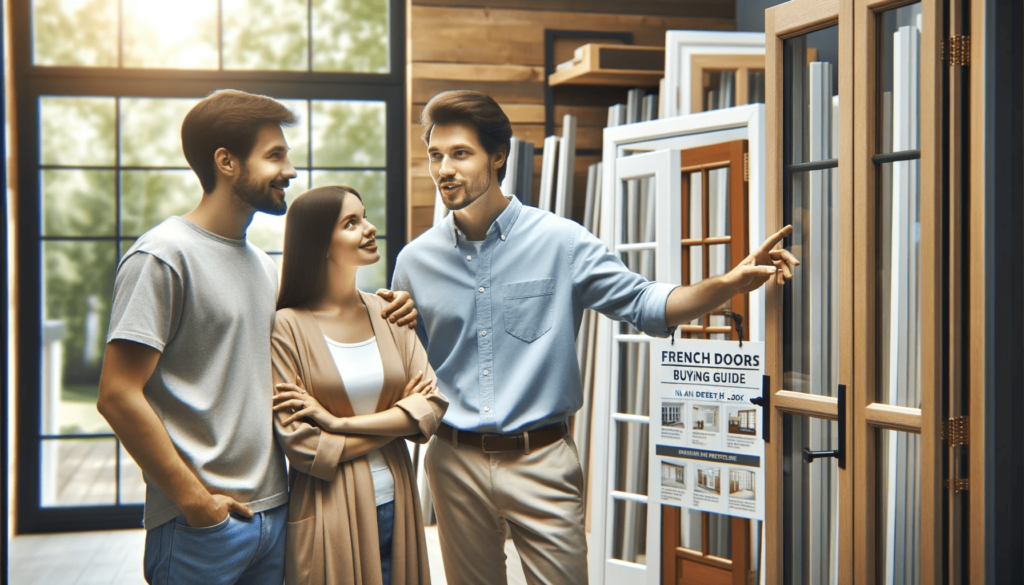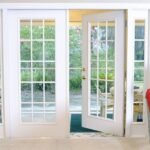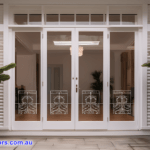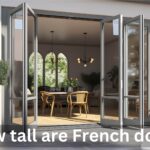
French doors are a popular choice for homeowners looking to enhance natural light, ventilation, and aesthetic appeal. With their characteristic large glass panes and narrow dividing frames, these elegant doors create an inviting indoor-outdoor flow.
This comprehensive guide provides aspiring French door buyers with everything they need to make an informed purchasing decision. We’ll explore French door history, benefits, materials, sizes, styles, installation, security features, energy efficiency, maintenance, costs, and more. Equipped with this knowledge, you’ll be ready to choose the perfect set of French doors to transform your home. So let’s get started!
Understanding French Doors
Definition and History
French doors, also known as French window doors, refer to hinged doors with glass panes extending most of their length. Instead of a single door panel, French doors have two door panels that open in the middle.
The origins of French doors date back centuries in Europe. Historic French architecture commonly incorporated these doors that opened onto balconies and patios, allowing an effortless transition between indoors and outdoors.
Over time, the elegance and functionality of French doors gained popularity worldwide in residential and commercial settings. Today, they are a sought-after way to infuse natural light, showcase views, and add character to any space.
Benefits of French Doors
There are many excellent reasons to choose French doors:
- Increased Natural Light – The expansive glass panes of French doors maximize daylight entering your home. This creates a brighter, airier environment.
- Improved Ventilation – French doors facilitate air circulation and fresh air flow when open. Their breezy, open-air feel is perfect for transitions between rooms.
- Enhanced Curb Appeal – Stylish French doors make an eye-catching statement from the curbside. They add instant aesthetic appeal and charm to your home’s exterior.
- Light and Views – French doors invite your eye to wander beyond them. They frame beautiful outdoor views and vistas from within your home.
- Seamless Indoor/Outdoor Flow – French doors extend your living space outdoors. Closed, they still maintain a visual connection outside.
- Space Expansion – French doors can make interior spaces appear larger, especially when leading the eye to adjoining rooms.
With this winning combination of form and function, it’s easy to see why French doors are a popular pick for homeowners. Keep reading to learn more about choosing the perfect set.
Choosing the Right Material
One of the most important decisions you’ll make is choosing the suitable French door material. Key factors include maintenance requirements, durability, insulation, cost and aesthetics. Let’s compare the benefits of different materials:
Wood, PVC, Aluminum: Pros and Cons
Wood
Wood remains the gold standard of French door materials, beloved for its beauty, longevity and customization options.
Pros:
- Natural aesthetic appeal
- Available in countless stain/paint colours
- Can match existing trim or floors
- Withstands weather and wear
- Excellent insulation properties
- Customizable design options
Cons:
- Requires rigorous maintenance
- Prone to warping/expanding
- Generally, the most expensive option
Popular wood choices are pine, oak, mahogany, and fibreglass. Opt for durable, dense woods resistant to rot, such as teak.
PVC (Polyvinyl Chloride)
PVC French doors offer lower maintenance than wood but mimic its look at a lower price point.
Pros:
- Minimal upkeep required
- Resists moisture, rotting, and insects
- Affordable compared to wood
- Available in various colours and finishes
- Energy efficient with multi-chamber construction
- Easily cleaned with soap and water
Cons:
- Can warp at high temperatures
- Prone to expansion and contraction
- Not as strong or durable as wood
- Limited customization options
Aluminum
Lightweight, durable aluminium French doors are ideal for humid, coastal climates.
Pros:
- Resistant to corrosion and rust
- Requires very little maintenance
- Withstands wind, rain, salt spray
- Strong, dent-resistant, and long-lasting
- Thermally broken frames enhance energy efficiency
- Costs less than wood doors
Cons:
- Conducts heat and cold easily
- Can dent or scratch more easily than wood
- Minimal customization options
- Industrial aesthetics are not suited to all homes
When choosing aluminium, opt for thermally broken frames filled with insulation to limit heat/cold transfer.
Latest Trends in Materials
Today’s eco-conscious homeowners can also find French doors made sustainably from:
- Recycled wood – Crafted using reclaimed barn wood, demolition lumber, orchard cuttings, and more.
- Bamboo – Made from quickly renewable bamboo stalks. Offers strength similar to some hardwoods.
- Composite – Blends synthetic resins with wood fibre/particles. Mimics wood with less maintenance.
- Fibreglass – Glass fibres bound in a weather-resistant polymer resin. It won’t warp, shrink, or swell.
Sizing and Style Considerations

Before purchasing French doors, you must determine the correct size and style options. Consider the following:
Measuring for French Doors
Precision measurements are crucial for proper French door installation and functionality. Be sure to measure:
- Opening Width – Measure across the centre of the door frame opening. Standard widths for French door units are 30-36 inches per door.
- Opening Height – Measure floor to top of the frame. Standard heights range from 6’8″ to 8 feet.
- Frame Depth – Depth required for installation into the opening. Often 4 9/16″ to 6 9/16″.
- Floor Clearance – Minimum 1/2″ space between bottom of door and floor.
These measurements will help you choose an appropriately sized French door unit for your opening.
Styles and Designs
French doors are available in an array of styles to match your home’s architectural character:
- Traditional – Classic French door style with divided lights and ornate hardware.
- Contemporary – Sleek, modern look with clean lines and large glass panes.
- Rustic – Barn door-style with imperfections and raw, reclaimed wood.
- Cottage – Romantic look with smaller glass sizes, grillwork, and a distressed painted finish.
- Transoms/Sidelites – Flank doors with matching stationary windows for added light.
- Arched – Eye-catching curved top shape. Requires wider radius opening.
There are also numerous glass patterns and door hardware options to customize your French doors’ look.
Installation Types
French doors can be installed to open either inward or outward. Considerations include:
In-swinging vs. Out-swinging Doors
In-swinging
Doors open into the room.
Pros:
- Take up zero exterior space
- Offer better security and weatherproofing
- Allow additions like screens without altering the exterior
Cons:
- Reduce interior floor space when open
- Hardware is prone to damage from internal collisions
Out-swinging
Doors open outward.
Pros:
- Don’t reduce interior space
- Hardware avoids interior damage
- Allow wider openings
Cons:
- Require exterior clearance for doors to open fully
- Less weatherproof and secure than in-swinging
- Additions like screens require modifying the exterior
In-swinging doors work well in rooms with ample floor space. Out-swinging doors maximize tight indoor areas. Consider your room dimensions, furniture layouts, and exterior clearance when deciding.
Security Features

Security is a priority for many homeowners. Fortunately, modern French door designs offer robust security options:
High-Security Locks and Advanced Features
- Multi-point locking systems engage multiple heavy-duty bolts into the door frame for reinforced security. Look for at least three locking points.
- Deadbolts offer added protection at the door’s edge or top/bottom corners. Opt for a 1″ throw length for maximum strength.
- Laminated glass layers make doors far harder to break through than traditional glass. Burglar-resistant glazing provides further security.
- Internal glazing beads prevent glass removal/entry from the exterior.
- Steel/reinforced frames, metal mesh screens, and security bars provide additional security layers.
Latest Trends in Security
- Innovative technology enables locking/unlocking doors remotely via smartphone.
- Alarm sensors trigger alerts if glass or doors are breached.
- Facial recognition and fingerprint scanning technology verify authorized access.
- Burglar-resistant glass is tested to withstand prolonged attack before compromising.
By leveraging the latest security innovations, today’s French doors can deliver ironclad protection and peace of mind.
Energy Efficiency and Eco-Friendliness
Environmentally conscious buyers should look for energy-efficient French door models:
Energy-Efficient Designs
- Insulated Glass – Multiple glass panes separated by gas-filled spaces minimize heat/cold transfer. Look for ENERGY STAR certification.
- Insulated Frames – PVC and fibreglass or aluminium models with thermal breaks prevent energy leaks.
- Weatherstripping – Tight seals block drafts and water infiltration around doors.
- Low-E Coatings – Microscopically thin metallic layers reflect infrared light for improved insulation.
- Argon/Krypton Gas – Inert gas injected between panes enhances insulation properties.
- ENERGY STAR Certification – Ensures doors meet strict energy efficiency standards for U.S. climates.
Latest News in Energy Efficiency
Look for cutting-edge features like Andersen Windows’ Polyurethane Thermal Break technology that enhances their French doors’ energy efficiency. Their design matches wood interiors with polymeric insulation and fibreglass exteriors for maximum energy savings and thermal performance.
Integration with Smart Home Technology
French doors can now integrate seamlessly with popular smart home platforms for enhanced security, convenience, and connectivity.
Smart Home Features
- Voice Control – Use smart speakers to lock/unlock doors with voice commands.
- Remote Access – Control doors remotely via smartphone, even when away from home.
- Activity Alerts – Get notifications about door activity, breaches, left-open alerts, and more.
- Smart Locks – Keyless, code-activated locking systems enable customized access.
- Integration – Connect door locks, sensors, and controls with home automation systems and security alarms.
Latest News in Smart Home Integration
An exciting development is Marvin Window & Door’s introduction of intelligent home-compatible French door products in their Integrity Wood-Ultrex line. The doors can integrate with systems like Google Home and Amazon Alexa for voice-activated control.
Homeowners can look forward to more French door options offering smart connectivity and home automation capabilities in the future.
Cost and Investment Value
French door prices vary based on materials, size, customization, accessories, installation costs, etc. Here’s an overview of cost considerations:
Pricing Overview
On average, expect to budget:
- Wood – $2,500 – $10,000+
- Fiberglass – $3,000 – $7,000
- Vinyl – $1,000 – $3,500
- Aluminium – $2,000 – $4,500
- Installation – $500 – $2,000
Luxury custom wood designs with premium finishes can cost tens of thousands. Basic aluminium models cost less on the low end.
Cost-Effectiveness
Though expensive initially, French doors add long-term value. Energy-efficient models can cut heating/cooling bills. High-end wood doors, in particular, yield strong ROI if you ever sell the home.
Latest News on Pricing
HomeAdvisor’s 2022 guide reports an average price of $2,545 to install new French doors. Their data shows 70% of homeowners paid between $1,124 and $5,200. This sizable range demonstrates the pricing variability based on materials, features, and labour costs in your area.
Maintenance and Upkeep
Regular maintenance preserves your French door’s beauty and performance. Follow these tips:
- Inspect weatherstripping and caulking yearly. Reapply sealants if needed.
- Check for signs of water damage around doors. Repair any leaks promptly.
- Test operation of latches and locks to ensure proper function. Lubricate hardware.
- Clean glass using vinegar/water solution or glass cleaner. Avoid harsh chemicals.
- Sand and refinish wood doors as needed. Spot paint aluminium and PVC doors when scratched.
- Remove debris and dirt from door tracks regularly. Hose off salt near oceans.
Proper care will help your French doors function smoothly while looking pristine for decades. Don’t neglect this important maintenance regimen.
Case Studies and Testimonials
The best way to understand the real-life impact of French doors is to hear from others’ experiences:
Real-Life Experiences
We installed double French doors leading from our living room to the patio. They make the room feel so much brighter and more spacious. Now we have a beautiful view of the garden that almost feels like part of the interior. The new doors also improved air circulation. Overall, it was one of our best home investments.
- Lucy D., Homeowner
Replacing our dark sliding patio doors with wood French doors transformed the look of our kitchen. They create such an elegant focal point. I love having the natural light streaming in while preparing meals. When weather permits, we open the doors wide for a seamless indoor/outdoor feeling. They’re also far easier to open and close than our old slider doors.
- James R., Homeowner
These first-hand accounts demonstrate how French doors can rejuvenate a home. As you decide, reflect on how French doors could enhance your living space.
Which French doors are considered the best and why?
When it comes to the best French doors options, many homeowners consider the ones made from high-quality materials like solid wood or fiberglass. These types of French doors offer durability, energy efficiency, and timeless beauty. Additionally, top-rated brands often provide customizable features and reliable security, making them a popular choice.
Can Misaligned French Doors Be Fixed with a Buying Guide?
When addressing the alignment of French doors, it’s crucial to consider factors such as the frame material and overall construction. With the right buying guide, you can find solutions for fixing misaligned French doors. Look for products designed to correct alignment issues and ensure smooth operation for your doors.
French Doors Check All The Boxes
French doors offer form, function and elegant aesthetic appeal. By understanding the nuances of materials, styles, sizes, installation and more, you can make the optimal selection to match your space and needs.
Use this guide to weigh the numerous options carefully. Thoughtful planning will ensure your new French doors check all the boxes for security, durability, energy efficiency and beauty. With the right pair of doors, you can reinvent your home and enjoy the benefits for years. Best of luck with your exciting French door project!

I’m James Davis, a carpenter with eight years of experience in carpentry services, repairs, installations, renovations, and maintenance of interior doors. I have a diploma in carpentry and joiner trade from the Education Skills Australia Institute and take pride in delivering high-quality results to ensure customer satisfaction. I’m a blog writer for Octopus Doors Company and enjoy sharing my knowledge and tips on maintaining security measures and choosing the right door materials, paints, or handle styles. I specialize in custom-made interior doors and strive to make every home look fabulous. Contact me anytime for help with door-related issues.










